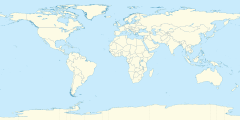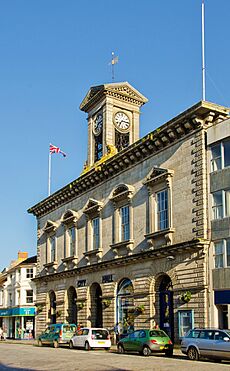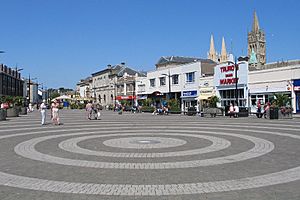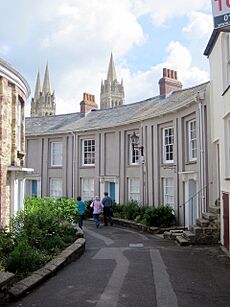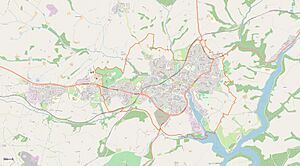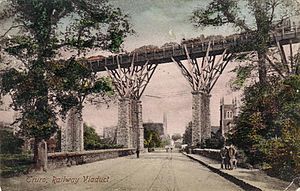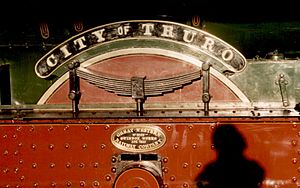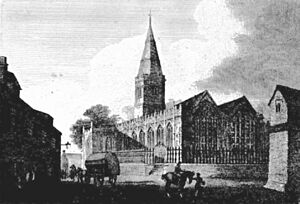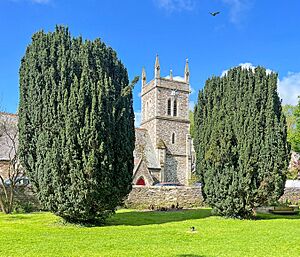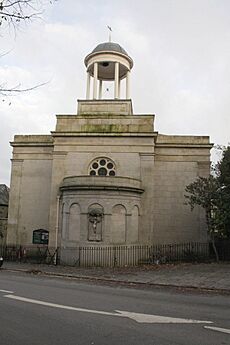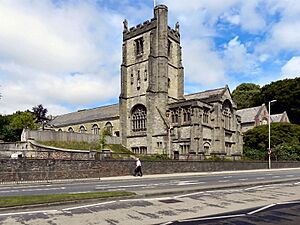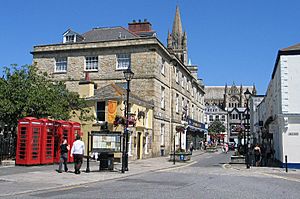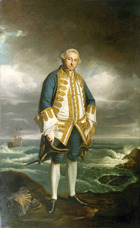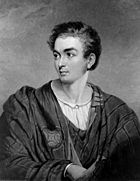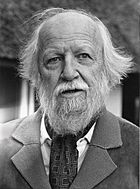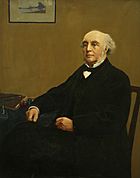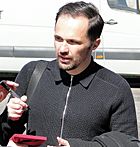Truro facts for kids
Quick facts for kids Truro
|
|
|---|---|
| City | |
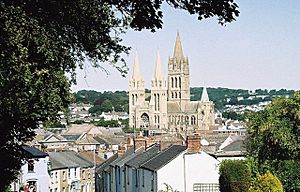 Truro Cathedral overlooking the city |
|
 Coat of Arms |
|
| Population | 23,047 |
| Demonym | Truroites |
| OS grid reference | SW825448 |
| • London | 232 miles (373 km) ENE |
| Civil parish |
|
| Unitary authority | |
| Ceremonial county |
|
| Region | |
| Country | England |
| Sovereign state | United Kingdom |
| Post town | TRURO |
| Postcode district | TR1-4 |
| Dialling code | 01872 |
| EU Parliament | South West England |
| UK Parliament |
|
| Website | truro.gov.uk |
Truro (![]() i/ˈtrʊəroʊ/; Cornish Standard Written Form: Truru) is a special type of city called a cathedral city and a civil parish in Cornwall, England. It is the southernmost city in the United Kingdom. Truro is about 232 miles (373 km) west of Charing Cross in London.
i/ˈtrʊəroʊ/; Cornish Standard Written Form: Truru) is a special type of city called a cathedral city and a civil parish in Cornwall, England. It is the southernmost city in the United Kingdom. Truro is about 232 miles (373 km) west of Charing Cross in London.
Truro is Cornwall's main town and its only city. It is a key place for government, fun activities, and shopping. In 2011, about 18,766 people lived there. By 2021, the population grew to 23,047. People from Truro are sometimes called Truronians. The city grew because of its port and its role in tin mining. It became a city in 1876 when the Diocese of Truro was created. Today, Truro is home to Cornwall Council, the Royal Cornwall Museum, Truro Cathedral, and the Hall for Cornwall.
Contents
What Does the Name Truro Mean?
The name Truro might come from the Cornish words tri-veru, which means "three rivers". However, some experts are not sure if "tru" really means "three". Another idea is that the name comes from tre-uro, meaning "settlement on the river Uro".
Truro's Story: A Look Back in Time
Early Days and the Castle
In the 1100s, a castle was built in Truro by Richard de Luci. He was a very important judge for King Henry II. The king gave him land in Cornwall, including the area where two rivers meet. A town then grew up around the castle. This town became a "borough," which meant it had special rights for trade and local government. The castle is no longer there today.
Richard de Lucy fought in Cornwall around 1138. He probably built the small castle in Truro in 1139–1140. The castle later went to Reginald FitzRoy. He was an illegitimate son of King Henry I. By 1270, the castle was already in ruins. Today, the Truro Crown Court stands where the castle used to be.
Growth and Challenges
By the early 1300s, Truro was a busy port. Its location inland helped protect it from invaders. It also made money from fishing. Truro was also a "stannary town." This meant it was a special place where tin and copper from Cornish mines were checked and officially stamped.
However, the Black Death (a terrible sickness) caused trade to slow down. Many people left, and the town became neglected. Slowly, trade and wealth returned during the Tudor period. In 1589, Queen Elizabeth I gave Truro a new charter. This allowed the town to elect its own mayor and control the port of Falmouth.
Civil War and Rivalry
In the 1600s, during the Civil War, Truro supported the king. A special mint was even set up to make coins for the king. But in 1646, the king's forces lost to the Parliament's army. The Royalist forces in Truro surrendered.
Later, Falmouth got its own charter, which gave it rights to its harbor. This started a long rivalry between Truro and Falmouth. They finally settled their dispute in 1709, agreeing to share control of the River Fal.
Prosperity and Modern Times
Truro became very wealthy in the 1700s and 1800s. This was thanks to better mining methods and higher prices for tin. Rich mine owners moved to Truro. You can still see beautiful Georgian and Victorian houses from this time on Lemon Street. Truro became a social hub, sometimes called "the London of Cornwall."
Many famous people lived in Truro. These included Richard Lemon Lander, who explored the River Niger in Africa. Henry Martyn was a missionary who translated the New Testament into other languages. Humphry Davy, who invented the Davy lamp (a safety lamp for miners), was also educated in Truro.
In the late 1800s, Truro's importance grew even more. It had iron-smelting factories, potteries, and tanneries. From the 1860s, a direct train line connected Truro to London. In 1876, Truro got its own bishop. The next year, in 1877, it officially became a city.
Where is Truro Located?
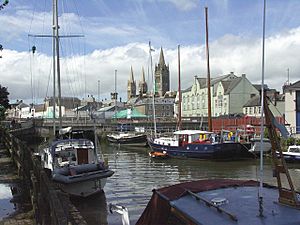
Truro is in the middle of western Cornwall, about 9 miles (14 kilometres) from the south coast. It sits where the rivers Kenwyn and Allen meet. These rivers then form the Truro River. This river is part of a system of waterways that lead to the River Fal and the large natural harbor called Carrick Roads.
The city is surrounded by steep valleys on the north, east, and west sides. It opens up to the Truro River in the south. This shape, along with heavy rain and high tides, caused serious floods in 1988. Since then, flood defenses have been built. These include a special dam on the River Kenwyn and a tidal barrier on the Truro River.
Truro is near several protected natural areas. These include the historic parklands at Pencalenick and beautiful gardens like Trelissick Garden. An area south-east of the city is part of the Cornwall Area of Outstanding Natural Beauty. There is also Daubuz Moors, a local nature reserve by the River Allen, close to the city center.
Truro has mostly grown outwards from its historic center. It has also expanded along the A390 to the west. As Truro got bigger, it included other small settlements as suburbs. These include Kenwyn, Moresk, Trelander, Newham, Highertown, Treliske, and Gloweth.
Truro's Weather
Truro, like the rest of Cornwall, has an oceanic climate. This means the temperatures are not as extreme as in other parts of England. It has a lot of rain, cool summers, and mild winters with very few frosts.
People and Jobs in Truro
In 2011, the Truro urban area had a population of 20,044. By 2021, this number grew to 23,047. Even though it's Cornwall's main place for shopping, fun, and government, it's only the fourth largest town in terms of population. However, Truro has been one of the fastest-growing cities in Cornwall in the 21st century.
Truro is known for having younger residents compared to other parts of Cornwall. About 77.7% of people are under 65. Many people who work in Truro actually live outside the city. This causes a lot of traffic. On average, people in Truro earn more money than in other parts of Cornwall.
Major employers in Truro include the Royal Cornwall Hospital, Cornwall Council, and Truro College.
Fun Things to Do in Truro
Places to Visit
Truro's most famous building is its Gothic-revival cathedral. It was designed by architect John Loughborough Pearson. Its tallest spire reaches 249 ft (76 m) above the city. The cathedral was built between 1880 and 1910. It stands on the site of an older church from over 600 years ago.
You can also see many beautiful Georgian buildings in Truro. These include houses on Walsingham Place and Lemon Street. People often say they are some of the best examples of Georgian architecture west of Bath.
Truro is a great place for shopping. It has many well-known stores, unique specialty shops, and markets. The indoor Pannier Market is open all year. It has many stalls and small businesses. The city is also popular for its restaurants, cafes, and nightlife. The Hall for Cornwall is a popular place for shows and entertainment.
The Royal Cornwall Museum is the oldest and most important museum about Cornish history and culture. It has collections about archaeology, art, and geology. Truro also has lovely parks like Victoria Gardens, Boscawen Park, and Daubuz Moors.
Events and Festivals
Lemon Quay is the main spot for most celebrations in Truro throughout the year.
In April, Truro gets ready for the Britain in Bloom competition. You'll see beautiful flowers and hanging baskets all over the city during the summer. A special continental market also visits Truro during the holidays. It offers food and crafts from many European countries.
The Truro City Carnival happens every September. It's a weekend full of music, art, activities for kids, and a fireworks show. There are also food fairs and a circus. A half-marathon race also takes place in September. It starts in the city center and goes into the countryside before finishing at Lemon Quay.
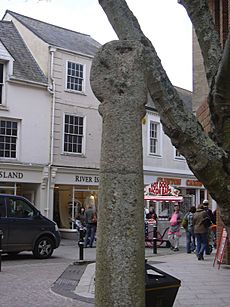
During Christmas, Truro has a Winter Festival. A special "City of Lights" paper lantern parade is a highlight. Local schools and community groups take part in this parade.
Sports in Truro
Truro has a strong sports scene. The Cornish Pirates rugby union team used to play here. Now, there are plans to build a new Stadium for Cornwall in Threemilestone. Truro's own rugby team, Truro RFC, was started in 1885. They play their home games at St Clements Hill.
Truro City F.C., a football team, is the only Cornish club to reach a high level in the English football league system. They won the FA Vase in 2007, which was a big achievement for a Cornish team. Their home ground is the Truro City Stadium in Threemilestone.
Cornwall County Cricket Club plays some games at Boscawen Park. This is also the home ground for Truro Cricket Club.
Truro Fencing Club is a top club in the country. They have won many national championships. Three fencers from the club even went to the London 2012 Olympics.
Other sports facilities in Truro include a leisure centre, a golf course, and tennis courts.
Cornish Wrestling
Truro has been a center for Cornish wrestling for a very long time. In the past, these wrestling events were called the "Great County Wrestling Matches." Winners received money, silver medals, cups, and belts. Many different places in Truro hosted these matches.
In the 1970s, Truro Cathedral School taught Cornish wrestling as part of its sports classes. It was the only school in Cornwall to do this at the time.
John Lander was a famous wrestler in the late 1700s and early 1800s. He was the father of the well-known explorers John Lander and Richard Lander.
Media and News
Truro is the center for local news in Cornwall. The county's weekly newspapers, the Cornish Guardian and The West Briton, are based here. Truro also has the studios for BBC Radio Cornwall.
Local Customs
A traditional play called a mummers play was thought to be from Mylor, Cornwall. But research now shows it actually started in Truro around 1780.
The famous Nine Lessons and Carols Christmas service began in Truro in 1880. The bishop of Truro, Edward White Benson, started it to give people a chance to sing carols before Christmas Day.
How Truro is Governed

Truro has its own local government called the Truro City Council. It is one of many parish bodies in Cornwall. The City Council manages things like the public library, parks, gardens, and tourist information. It also looks at plans for new buildings. The city council has 24 councillors who are elected every four years.
Above the City Council is the Cornwall Council. This is a larger government body for all of Cornwall. It handles bigger issues like planning and development. Cornwall Council is based west of Truro city center. Truro elects four members to the Cornwall Council.
Truro became a "free borough" in 1589 and a city in 1877. This happened after it got its own Anglican diocese in 1876. However, Truro is still one of the smallest cities in the UK by population and area.
Sister Cities
Truro is twinned with:
- Boppard, Germany
- Morlaix, France
Other Places Named Truro
Several towns outside of Britain are also named Truro:
- Truro, Nova Scotia, Canada
- Truro, Massachusetts, United States
- Truro, Iowa, United States
- Truro, South Australia, Australia
Getting Around Truro
Roads
Truro is about 6 miles (9.7 km) from the A30 main road. It is connected to the A30 by the A39 road from Falmouth. The A390 road also goes through Truro. This road connects Redruth to the west and Liskeard to the east. From Liskeard, you can join the A38 to get to Plymouth and Exeter.
Buses
Truro has many bus services. Most routes end at Truro bus station near Lemon Quay. A special "Park and Ride" system, called Park for Truro, opened in 2008. Buses from a car park in Threemilestone take people into the city. They stop at places like Truro College, the Royal Cornwall Hospital, and the railway station.
Long-distance coach services also serve Truro. You can take coaches to London, Birmingham, and Penzance.
Trains
Truro railway station is about 1 mi (1.6 km) from the city center. It is a stop on the Cornish Main Line, which runs between Penzance and Plymouth. Two train companies serve Truro:
- Great Western Railway has services to Penzance, Plymouth, Reading, London Paddington, Bristol Temple Meads, and Cardiff Central.
- CrossCountry runs services between Penzance, Bristol Temple Meads, Birmingham New Street, York, Newcastle, and Edinburgh Waverley.
Train History
North-east of the station is a 28-metre-high (92-foot) stone viaduct. It offers great views of the city and cathedral. This viaduct replaced an older wooden one built by Isambard Kingdom Brunel in 1904. The Maritime Line also connects to the main line at Truro, going to Falmouth.
Truro's first train station opened in 1852. It was called Truro Road station. Later, a new station was built above the city center, which is the one used today. The old train route from Highertown to Newham is now a walking and cycling path called the Newham Trail.
Air Travel
Newquay Airport, Cornwall's main airport, is about 12 mi (19 km) north of Truro. It has regular flights to London Heathrow and other airports.
River Travel
You can take a boat from Truro to Falmouth along the Truro and Fal rivers. These boats run four times a day, depending on the tide. They stop at places like Malpas and St Mawes along the way.
Churches in Truro
The old parish church of Truro was St Mary's. It was built into the cathedral in the late 1800s. The original church building dates back to 1518.
Other churches were built later. St George's church was built in 1855 from Cornish granite. It has a large wall painting behind the altar by Stephany Cooper. This painting shows views of Zanzibar, Truro, and saints.
St John's Church was built in 1828 in a classical style. St Paul's Church was built in 1848. Unfortunately, St Paul's Church is no longer used because it has fallen into disrepair. Services are now held at St Clement, St George, and St John churches.
Other Religions
Truro also has a Methodist church, a Quaker Meeting House, and other churches. St Piran's Roman Catholic church was built in 1973. The Baptist church is on the site of an old pottery.
Learning in Truro
Truro had a free grammar school in the 1500s. Famous students included the scientist Sir Humphry Davy and the missionary Henry Martyn.
Today, Truro has many schools and colleges:
- Archbishop Benson – A primary school.
- Polwhele House Preparatory School – A school that also teaches the boy singers for Truro Cathedral.
- Truro School – A private school founded in 1880.
- Truro High School for Girls – A private school for girls aged 13–18.
- Penair School – A state school for ages 11–16.
- Richard Lander School – A state school for ages 11–16.
- Truro and Penwith College – A college for further and higher education.
- University of Exeter Medical School.
Future Plans for Truro
Truro has many plans for new developments. Most of these plans aim to solve problems like traffic congestion and a lack of housing.
One big plan is to build a new road to take traffic away from busy areas. This road will also help new housing developments.
For the city center, there are plans to limit traffic on some main shopping streets. There are also efforts to turn old commercial buildings back into homes. Since March 2023, some streets in the city center have restricted traffic.
The old Carrick District Council site on Pydar Street will be redeveloped. This will create much-needed homes. It will also allow a part of the University of Falmouth to move to Truro. The plans include a hotel, restaurants, and public spaces. A large development called Langarth Garden Village is also being built. It aims to provide homes for 8,000 to 10,000 people.
Along the waterfront, a tidal barrier is planned for the Truro River. This will help with the mud banks that appear at low tide.
Other plans include building an urban extension to the west of the city. This might include a new stadium for Truro City F.C. and the Cornish Pirates. There is also a possibility of moving the city's golf course to make space for more homes.
Famous People from Truro
Important People and Public Service
- Edward Boscawen (1711–1761), a Royal Navy admiral. A street and a park in Truro are named after him.
- Henry Martyn (1781–1812), a mathematician and missionary. He translated the Bible into other languages.
- Richard Lemon Lander (1804–1834), an explorer in West Africa. A school and a monument are named after him.
- John Lander (1806–1839), an explorer who worked with his brother Richard.
- David Penhaligon (1944–1986), a politician who was a Member of Parliament for Truro.
- NneNne Iwuji-Eme (born c. 1978), a British diplomat.
- Staff Sergeant Olaf Schmid (1979–2009), a British Army bomb-disposal expert.
Artists and Writers
- Samuel Foote (1720–1777), an actor and playwright.
- Joseph Antonio Emidy (1775–1835), a former slave who became a violinist.
- William Golding (1911–1993), a famous novelist who won the Nobel Prize in Literature. He lived near Truro.
- Roger Taylor (born 1949), the drummer for the rock band Queen.
- James Marsh (born 1963), a film director who won an Academy Award.
- Paul Kerensa (born 1979), a comedy writer and stand-up comedian.
Scientists and Business People
- Elizabeth Andrew Warren (1786–1864), a botanist who studied plants and seaweeds.
- Charles Foster Barham (1804–1884), a doctor and writer on public health.
- Edwin Dunkin (1821–1898), an astronomer.
- Edward Arnold (1857–1942), a publisher who started his own company.
Sports Stars
- Nick Nieland (born 1972), a javelin thrower who won a gold medal at the 2006 Commonwealth Games.
- Matthew Etherington (born 1981), a former professional footballer.
- Annabel Vernon (born 1982), a retired rower who won a silver medal at the 2008 Summer Olympics.
- Chris Harris (born 1982), an international speedway rider.
- Gemma Prescott (born 1983), a Paralympic track and field athlete.
- Luke Cowan-Dickie (born 1993), a rugby union player.
- Jack Nowell (born 1993), a rugby union player.
- Molly Caudery (born 2000), a British pole vaulter.
Images for kids
See also
 In Spanish: Truro para niños
In Spanish: Truro para niños


